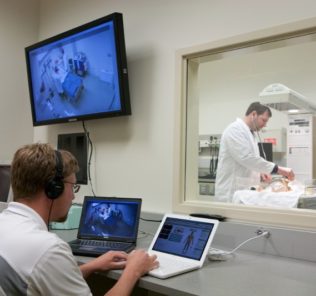Latest Clinical Simulation News From Around the World | February 2021
Helping healthcare simulation educators, administrators and learners to stay up to date on industry topics, HealthySimulation.com finds and shares relevant news and information from around the world. This news includes medical simulation innovations, products, vendors, research and more. Check out some of the world’s latest clinical simulation news by exploring the following updates:
UF CELS Debuts Female Trauma Simulator
The University of Florida Center for Experiential Learning and Simulations was recently the first center in the United Stated to debut a female trauma simulator developed by Operative Experience, Inc. (OEI) The simulator, nicknamed “007” is completely anatomically accurate, and was molded to model the physique — and potential injuries — of a female soldier.
Sponsored Content:
According to OEI, research shows that treating female trauma patients is a skill set that is lacking in both U.S. military and civilian hospital settings. This is why training with high fidelity simulators such as 007 is so important across military and civilian healthcare simulation. By using 007 to train, learners and practitioners have the opportunity to become comfortable with the presentation and high-stakes care involved with trauma patients.
“Over the last 25 years of using high-fidelity simulators, we’ve learned that training with simulators and using advanced experiential learning techniques enable our healthcare providers to react in an almost instinctive, professional and knowledgeable way when they’re faced with traumatic situations,” said Lou Oberndorf, CEO and chair of OEI.
Rural Hospitals Adopt Telehealth Solutions
In early 2021, OSF HealthCare and the University of Illinois College of Medicine at Peoria, through Jump Simulation, collaborated with Chicago-based Northwestern University on a four-year, $750,000 grant from the Agency for Healthcare Research and Quality. The project’s goal was to create patient simulations that allowed for use of a telehealth cart. The cart would provide direct video communication with an electronic intensive care unit (eICU) in Peoria, Illinois. This was designed to connect rural emergency departments with caregivers treating patients with severe sepsis and septic shock.
Sponsored Content:
According to OSF Healthcare, the study looked at expanded use of remote monitoring for rural emergency departments, which have a small staff that can easily be overwhelmed if they have multiple severely ill patients. With sepsis patients, the research introduced remote monitoring earlier. The monitoring included cameras on the telehealth cart, patient vitals as seen on in-room monitors, conversations between the ED staff and eICU nurses via telephone, or a combination of the three.
A standard participant was used to indicate during debriefing sessions that in a real life situation, most patients and their families would find knowing a remote eICU nurse was also keeping an eye on them to be comforting. The three-act clinical simulation used scenarios during which the patient continued to decline, followed by staged debriefings. The results are still being evaluated, including the reluctance by some care team members to use the technology as currently set up. OSF Healthcare explains that these barriers can likely be overcome by improved telehealth integration, reducing or eliminating the need for a separate cart.
Elsevier, SimX Partner to Include SLS for Registered Nurses (RN) With Virtual Reality
Elsevier has announced that the company is partnering with SimX, a developer of VR simulation training, to include the Simulation Learning System for RN with virtual reality (SLS with VR) as part of Elsevier’s portfolio of products for nursing health and education. The innovative SLS with VR features 100 virtual reality simulation scenarios and over 160 lab-based scenarios. This is significantly more than any other VR nurse training solution currently available.
This partnership is coming at a very critical time for the nursing field worldwide, given a global nurse shortage. Additionally, educational institutions are struggling to increase program enrollment due to increasingly limited clinical placements and lack of faculty capacity. To combat this issue and prepare nursing learners to enter the clinical setting, more programs have turned to healthcare simulation (including VR-based training) to replace clinical hours and help support educators in teaching large classes.
To-date, numerous nursing programs have piloted SLS with VR and have seen success from using the solution. Another benefit of SLS with VR virtual training is that each scenario creates an environment where learners can gain valuable “hands-on” patient care experience, enhance their clinical judgment skills and gain more confidence. Every virtual experience is accompanied by detailed instructions for preparation and implementation of the scenario, debriefing questions that encourage critical thinking, learning resources to reinforce student comprehension, and much more.
These features allow nursing instructors to easily extend and supplement their curriculum and medical simulation program in real-time. This allows them to teach more learners with improved student outcomes to instill confidence in more nurses for when they enter the clinical setting. SLS with VR presents an affordable way to provide simulated clinical experiences while reducing the need for simulation labs, manikins, and other simulation lab equipment, which can cost nursing programs hundreds of thousands of dollars.
ACEP SIM’s SimBox Education Project
Developed by ACEP SIM, the SimBox Education Project provides free open access to medical simulation resources for healthcare workers in non-tertiary or prehospital environments. The goal of the initiative is to improve the readiness of emergency and prehospital staff to triage, resuscitate, and transfer critically ill infants. To achieve this, regular use of the SimBox will improve team pediatric resuscitation skills and equipment, and demystify pediatric guidelines.
SimBox can be run from anywhere, eliminating the need to leave the station. The solution features low cost equipment and specially curated teaching tools to make this resource convenient to use in the workplace. An updated recipe for remote learning includes an online scenario and practical teaching guides, including how to run a drill and links to pediatric resources. No clinical simulation or pediatric experience are required to use SimBox.
inciteVR is a virtual reality simulation company that specializes in the production of immersive learning products for higher education and professional training. Headquartered in Weldon, California, the company is a market leading pioneer for online learning through immersive learning experiences (ILX) featuring hand-tracking with mobile VR and rich Cloud enterprise features.
The company’s Clinic Immersives NP Skills Labs Enterprise allows nurse practitioner learners to develop clinical lab skills using their own affordable Oculus Quest mobile VR with unlimited access from anywhere and at any time. The sim labs use hand-tracking inputs to practice in either guided or expert modes. Specific nurse practitioner skills included in the company’s skills labs are intubation, arterial line, central line, thoracentesis, paracentesis and suturing. These skills labs provide insight for every aspect of learner performance and work to close learner and class skills gaps.
InciteVR-Purdue-Global-White-Paper: This paper investigates a subset of the myriad tools and processes used in developing immersive learning – which incorporates the use of an embedded physiology engine framework to both leverage empathy and broaden the diversity of clinical practice experiences.
Laparo Medical Simulators
Laparo Medical Simulators was originally founded by three friends with a passion for medical technology. They started from a simple idea: They knew that manual practice is important for surgeons, and how dangerous and expensive making a mistake in the field can be. They began by designing an initial laparoscopic simulator and their global adventure was ignited.
Today, Laparao Medical Simulators is a manufacturer of a wide range of laparoscopic trainers and simulators. The company has two product lines: individuals and professionals. The individual line is dedicated to learners and young physicians. As the access to hands-on laparoscopic training is limited not only during the COVID-19 pandemic, Laparo Medical Simulators designed the LAPARO Aspire and LAPARO Advance simulators to enable future surgeons to excel in laparoscopic skills whenever they prefer and however often they need.
The line of professional simulators are dedicated to medical universities, hospitals and simulation centers. Within this line, two options for the Advance are available: the Advance portable and Advance Training Station. Additionally, Laparo Medical Simulators’ flagship product, the LAPARO Analytic, allows for solo training. A learner can create a user account, choose a training type, watch the tutorial on how the training should be done and send the video to an instructor or leave it for professor assessment. The LAPARO Analytic also gives automatic feedback.
Virtual Electrosurgical Skill Trainer Tool
The Virtual Electrosurgical Skill Trainer (VEST) is a healthcare simulation training tool that can be used to teach learners the situational awareness they would need if a fire were to break out in the operating room. This immersive virtual reality solution creates a safe but realistic environment where they can engage in experiential learning. The VEST clinical simulation solution is scalable, available anywhere and at any time, and is composed of five modules:
- Module 1: Tissue effects
- Module 2: Direct and capacitive coupling
- Module 3: Bipolar tools
- Module 4: Currents within the human body and placement of the dispersive electrode
- Module 5: Operating room (OR) fire training
To demonstrate VEST’s potential, a study published in the National Library of Medicine titled “OR fire virtual training simulator: design and face validity” sought to establish the virtual OR fire simulator’s face validity. During the study, 49 subjects were asked to complete the OR fire training/prevention sequence in the VEST simulator. They were then asked to answer a subjective preference questionnaire consisting of 16 questions, focused on the usefulness and fidelity of the simulator.
Ultimately, 33 of the 49 participants (67%) chose the virtual OR fire trainer over traditional training methods such as a textbook or an animal model. Thus, the study concluded that the face validity of the VEST simulator OR fire training module was successfully established on many aspects of the clinical simulation. This means that training for OR fire emergencies in fully immersive VR environments, such as the VEST trainer, may be the ideal training modality.
Savior Medical
Savior Medical provides moulage services, equipment and training in high end medical simulation and make up for training, film, or educational purposes. The company also offers courses, check cards, and consultancy.
As for medical equipment, Savior Medical offers Savior Strechers, the Savior Squatic Sled, Savior IEC kits, the Savior Carry EZ, downloadable resources and a product gallery. To take the memory test out of pre-hospital care, at the point of treatment and during training, treatment check cards and scenario training check cards are available. Courses range from maritime immediate emergency care courses, to maritime casualty care courses, advanced aquatic care courses, medical moulage and simulation courses, and medical simulation for make up professionals courses.
Managing Director of Saviour Medical, Paul Savage OBE, has a proven track record in designing, advising and implementing total clinical governance solutions to a variety of organizations. His experience ranges from single-site industrial rescue teams to the RNLI, which spanned 750 sites across the UK and Republic of Ireland. This experience allows him to produce appropriate robust and defendable solutions which are not cost intensive or unmanageable.
Subscribe for More of the Best Medical Simulation Updates!
Lance Baily, BA, EMT-B, is the Founder & CEO of HealthySimulation.com, which he started while serving as the Director of the Nevada System of Higher Education’s Clinical Simulation Center of Las Vegas back in 2010. Lance is also the Founder and acting Advisor to the Board of SimGHOSTS.org, the world’s only non-profit organization dedicated to supporting professionals operating healthcare simulation technologies. His co-edited Book: “Comprehensive Healthcare Simulation: Operations, Technology, and Innovative Practice” is cited as a key source for professional certification in the industry. Lance’s background also includes serving as a Simulation Technology Specialist for the LA Community College District, EMS fire fighting, Hollywood movie production, rescue diving, and global travel. He and his wife Abigail Baily, PhD live in Las Vegas, Nevada with their two amazing daughters.
Sponsored Content:




















